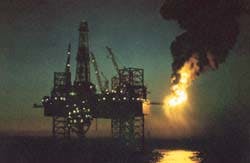Canada's Northeast spurred by major acquisitions
Amoco joins race to develop Newfoundland aquatory; Chevron increasing its share
Nova Scotia's Panuke Field was Canada's first offshore producer.
As Hibernia, Newfoundland's solitary Grand Banks field inches toward development, the ever-growing complex of prospective structures in its environs appears to be attracting a bit more interest.
The 615 million bbl Hibernia is on track, albeit a slow one due to the size and scope of its gravity base structure (GBS), and is amazingly still within its pre-production budget of C$5.8 billion. The GBS is nearing completion, according to Ken Hull, president of Hibernia Management and Development Co., and the topsides facilities are also drawing near completion. (Once production begins, capital costs of $3.3 billion will begin to accrue. Operating expenses over the 19-year life of the field are estimated at $7.5 billion.)
"The Hibernia platform is more than 87% complete overall. We are confident of meeting our schedule and budget to achieve first oil by December 1997," Hull said.
Despite the approaching completion of the project, however, both the government of Canada and Petro-Canada still want to sell some of their stake in Hibernia. Petro-Canada hopes to sell off half its 25% interest, and at least one potential buyer has been in discussions with the state oil company to lessen its burden, Amoco. Amoco Canada has been quietly negotiating with Petro-Canada as well as the other shareholders - Chevron, Gulf, Murphy, and Mobil - not only with the intention of buying an interest in Hibernia, but to participate in the development and production of other oil and gas prospects in the Jeanne d'Arc Basin and possibly off New-foundland's west coast.
Amoco Canada's chairman David Newman says the company will spend $90.3 million on new concession blocks. The company already plans to hire a drilling rig this summer to drill two wells next year in its West Bonnie Bay, Block 1020 and 1022 north and southeast of Hibernia, respectively. Newman says the additional $90.3 will be spent on exploration and development by the year 2000.
Amoco isn't the only operator expanding its interests in the area. Chevron Canada has bought Norcen Energy's shares in several Grand Banks concessions, including Hebron, Ben Nevis, and West Ben Nevis Fields, increasing its interest in Hebron to 32%, and giving it a 17% interest in Ben Nevis.
The three fields, discovered in the early 1980s, lie some 35 km to the southeast of Hibernia in water depths of 80-100 meters, just to the north of Terra Nova Field, and hold combined reserves of 195 million bbl oil. Mobil and Petro-Canada hold the remaining interest in the Chevron-acquired fields, Mobil as operator of Hebron, Petro-Canada as operator of Ben Nevis.
Canadian Oxy, not to be outdone, is farming into exploration of Block 1008 in St. George's Bay, where Talisman Energy is the operator.
Terra Nova, which could be in production at about the same time as Hibernia, 25 km away, was discovered by Petro-Canada. With reserves of 405 million bbl, it could achieve production rates of 75,000-100,000 b/d oil and 75 million cf/d gas from its planned 44 subsea wells. Petro-Canada is operator, with Mobil, Murphy, Husky, and Mosbacher as partners.
Whiterose, 50 km northeast of Hibernia, was discovered by Husky/Bow Valley. It holds reserves of more than 178 million bbl oil, 1.5 tcf gas, and 50 tcf of gas liquids. Hebron and Ben Nevis,
The Hibernia gravity base being towed to deepwater site.
New Offering
To stimulate even further interest in Newfoundland's aquatory, the Canada-Newfoundland Offshore Petroleum Board has issued a call for bids for eight new blocks with a total of just under 910,000 hectares. Four of the blocks are in the Jeanne d'Arc Basin of the Grand Banks, two north of Hibernia, one south, and a very large block, Parcel No. 3, farther away to the east. The other four blocks are off the west coast of Newfoundland in the Gulf of St. Lawrence near the highly prospective St. George's Bay. (Despite a lack of interest the last time it was offered, Canada is also once again offering its northern reaches, its Beaufort Sea, Banks Island area, and the Sverdrup Basin of the Arctic Islands for bids - so far with no takers.)
Nova Scotia
To date, however, Canada has achieved only one producing offshore field, Cohasset, off Nova Scotia's Sable Island. Its operator, Lasmo Nova Scotia, expects production to average 40,000 b/d in achieving total production of 30 million bbl oil from the 11 wells of the field. (Panuke Field, which was initially tied in to nearby Cohasset, was a brief producer, but has since ceased production.)
Canada has, nevertheless, defined a sizable gas province centered on Sable Island, which Mobil, the operator, maintains will meet a 1999 production date to provide gas to the US east coast. Some 19 sizable discoveries of gas reserves have been found, but bringing them onstream, a US$3 billion project, is still on hold until customers can be established and contracts signed.
Approximately 6.4 tcf gas and 217 million bbl oil and natural gas condensate have been discovered off Nova Scotia's Sable Island, but the Scotian Shelf is still relatively unexplored, with many undrilled prospects. Estimates are that the known reserves represent only 35% of the total gas potential, 20% of the oil and condensate potential.
Copyright 1996 Offshore. All Rights Reserved.


